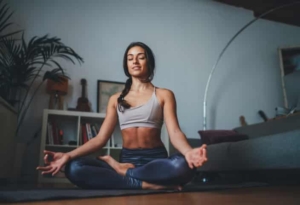Meditation: 10 tips & 7 exercises on how to meditate

People who meditate regularly are calmer, more relaxed, more serene, and often happier. But how does meditation actually work? We’ll show you how you can easily learn to meditate.
Meditation can help your mind focus on something, i.e. your body, your breath, or even a mantra. You not only strengthen your mind but you can also heighten your emotional intelligence.
What meditation is

What meditation is: a definition
Meditation is a spiritual practice practiced by many cultures. It is about quieting the mind and allowing thoughts to settle. This has the benefit of reducing stress and even expanding awareness.
The techniques used in meditation vary widely: some meditations work by walking or dancing, and some require drumming or other musical elements.
However, the most common forms of meditation are those that take place in silence. These are the techniques we will focus on in this text. By the way, the much-used buzzword "mindfulness" is closely related to meditation. After all, meditation is also about becoming more mindful and open to the little things.
Tips on learning how to meditate for beginners
Anyone can learn meditation. At first, most people find it difficult because the practice requires time and patience. We give tips on how to learn to meditate.
Don’t expect miracles
The first exercises in learning to meditate are easy, but you won’t get to mastery in no time. Don’t be frustrated if you find meditating difficult at first, or maybe feel like it won’t do much good at all.
Every practice brings you forward and helps you become a little calmer. However, to experience great wisdom, relax even in the most difficult situations, or possibly even expand your consciousness, you need to practice for a long time.
Create a suitable place

Find a suitable place to meditate
Ideally, you should meditate in the same place over and over again. The advantage: After some time your mind switches to relaxation just by entering the place. A suitable meditation place should be nicely furnished and offer as few distractions as possible.
For example, you can make a small table or shelf with a candle, some flowers, and an inspiring picture into a wonderful meditation place. If you don’t want to set up a permanent place, it’s also enough to use a specific mat or pillow each time you meditate.
And if you don’t want to do that either, of course, you can do it without a permanent place. But if you meditate regularly, it will probably do you good.
Wear comfortable clothes
Nothing is more annoying than a pinching waistband or a too-tight collar during meditation. Such small disturbing factors suddenly have a very strong effect on the quiet of meditation and are simply unpleasant.
Turn off distractions
During your exercise, you should not be disturbed. Therefore, tell your family members or choose a time when you are alone in the house. Very important: turn off your cell phone or put it in another room where you can’t hear it.
Ideally, you should also turn off the doorbell. Then you can start your meditation practice undisturbed.
Choose a meditation posture

Typical posture when meditating
The typical meditation posture is a variation of cross-legged sitting. But it doesn’t have to be, you can also sit on a chair or kneel on the floor with the help of a meditation cushion, for example.
It is also possible to meditate lying down, but there is a risk that you will quickly fall asleep. Of course, this is not the purpose of meditation. When you sit or kneel, you should make sure that your back is as straight and upright as possible.
The advantage of meditating while lying down is that you can position yourself in a completely relaxed way – your spine is stretched and back pain should not be a problem.
Start with short meditation sessions
Meditations that last for hours are hardly feasible in the beginning and are usually very uncomfortable for the untrained. Such a long duration is not even necessary. Units of five or ten minutes are quite enough for the beginning.
Just push away looming thoughts
Almost all meditations are about letting your thoughts settle down. What sounds so simple can be terribly difficult. In the beginning, you’ll probably catch yourself indulging in a thought every few seconds after all.
This is quite normal. The important thing is not to get angry, or your distraction will increase. Just push the thought lovingly aside and return to your exercise. Little by little, you will find it easier and easier.
Exercise regularly
As with many things, meditation comes down to regular practice. The more often you meditate, the easier it will be, and the deeper you will get into relaxation. The ideal would be to practice daily, but even two to three practice sessions a week are great.
Hold on while meditating

Hang in there while you meditate
When you meditate, you don’t do anything (at least on the surface). This is very unfamiliar to most people. No wonder your body and mind resist it at first.
Don’t be surprised if you feel the irresistible urge to get up after a short time. Or if your nose suddenly itches, your back hurts and your feet get cold.
Maybe even during the exercise you are convinced that it is complete nonsense to continue meditating. Hang in there anyway!
After all, in the beginning, it’s only a few minutes, it’s manageable. You will see: Little by little, these defensive reactions will become noticeably weaker.
Come back gently from meditation
When meditating, you decelerate and get off the hamster wheel of everyday life for a few minutes. Getting back on that hamster wheel immediately after the practice would be a shame. Take a few minutes after the meditation to get back to everyday life.
If you like, drink a glass of water or eat a snack, stretch or gently pat yourself down. All of these physical stimuli will help you fully re-engage with reality.
Guided meditations help especially beginners who have difficulties with concentration. In this case, speakers accompany your meditation session, for example, via a video, audiobook, or in a course. You are guided by the speaker telling you again and again where to focus your attention.
Learn meditation with these exercises
In addition to our tips, here are practical exercises on how to learn meditation that you can easily incorporate into your daily life. They’ll help you relax and let go.
Mindfulness meditation
In mindfulness meditation, you observe your thoughts and perceptions without judging or controlling them. If new ideas or thoughts come up, you welcome them.
You do not favor anything and then let them pass by again. This is also the goal of this practice: to understand when thoughts arise in your consciousness and to be able to let them go again;
Metta Meditation

What metta meditation is
Metta meditation, also called loving-kindness meditation, is mainly about love. Not only towards yourself, but also toward other people around you.
Certain mantras that you repeatedly call to your mind’s eye help you to have more compassion and unconditional love for the world around you.
The phrases you speak in your mind include the following:
- May I be well.
- May I be content and relaxed.
- May you be well and relaxed.
- May you have peace and find inner peace.
In the practice you imagine these sentences first for yourself, then for a close person you love. In the third phase, you apply the mantras for a person who is neutral to you. Finally, you recite the phrases for someone you have not held in high esteem.
Breathing Meditation
Breathing meditation is the basis of many other techniques. It is quite simple to perform: Get into your preferred meditation posture, set a short-time alarm – if you like – and close your eyes.
Now just concentrate on your breath. You don’t have to change it, just notice what is there right now. Trace the breath as it enters your body through your nose or mouth, flows down your windpipe into your lungs, and expands your upper body, only to immediately return and leave your body.
Visualization

Visualize your favorite place meditatively
Visualization means using the power of your imagination in meditation. And it goes like this: Get into your meditation posture and close your eyes. Then imagine a place where you feel really comfortable and where you can recharge your batteries.
This can be a beach or a lakeshore, a forest clearing, a cave or a completely different place. Whether you have seen the place before or are just imagining it is irrelevant. Imagine yourself staying in this place and recharging your batteries.
Try to notice as many details as possible. Listen to the birds chirping or the waves, also pay attention to smells and the feeling of the ground beneath you. Concentrate completely on your place as long as the exercise lasts. You can return there again and again in meditation to recharge your batteries.
Affirmations
Affirmations are words or short phrases that you say to yourself during meditation. For example, say to yourself, "I am calm and relaxed" or "I am grateful for what I have." Feel free to make up your own affirmations to use during meditation. However, make sure that the sentences are short, clear and positive. Refrain from using negations.
Attention to the body
This mindfulness meditation is about feeling your body. As you meditate, gradually direct your attention to each part of your body. Start with your toes and slowly work your way up until you reach your head.
How small-step you take depends on how much time you want to invest in meditation. Pay attention to your body and notice how it feels. Where do you have tension, pain or discomfort? Where does your body feel good and powerful? You don’t have to change anything, just notice what is there.
Grounding
In this exercise, devote your attention to the ground under your feet (or under your back if you are meditating in a lying position). Imagine roots growing from your feet or back.
They effortlessly penetrate the ground beneath you, as well as the floors below, until they reach the fertile earth beneath you. Imagine how you are firmly connected to the ground and how power flows from there into your body.
Before you end the meditation, imagine how the roots withdraw from the earth back into your body.
Other types of meditation
There are many different types of meditation. However, some of them are so complex that you cannot learn them on your own and need a guide. These include, but are not limited to, the following:
- Transcendental Meditation
- Sleep Meditation
- Vipassana Meditation
- Christian Meditation
- Spiritual Meditation
- Movement Meditation
- Loving-kindness Meditation
- Mantra Meditation


